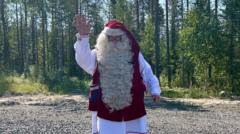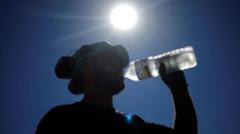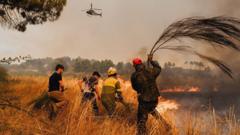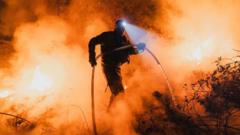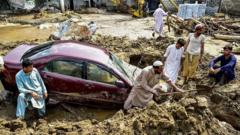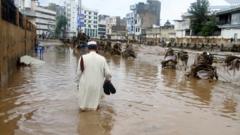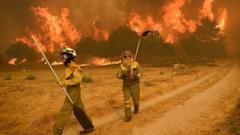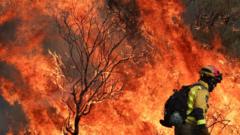In an unusual twist this summer, Santa Claus finds himself in a rather sweltering situation as Rovaniemi, the capital of Lapland, grapples with an unprecedented heatwave. With temperatures soaring to around 30 degrees Celsius, the North Pole’s famous gift-giver is now instructing his elves to stay hydrated amidst the sweltering conditions, a stark departure from their usual winter preparations.
“The reindeer require constant water, and so do you,” Santa cheerfully reminds his busy team, as they assemble toys for the upcoming Christmas season. Due to the extreme heat, he remains mostly indoors, satisfied with heading out for a swim in the nearby lake only after the sun goes down. “It cools off a bit after 6 PM, which is when I venture outside,” he notes.
The exceptionally high temperatures that have plagued northern Finland can be attributed to bizarre climatic patterns, where after a wet and cold spring, it suddenly transformed into an enduring heatwave. By July 25, the temperature in Rovaniemi had consistently exceeded 25 degrees Celsius for a staggering fifteen days. Meteorologist Jaakko Savela from the Finnish Meteorological Institute points out that heatwaves of this nature are extremely rare in Lapland, with the previous record dating back to 1972, which lasted at most fourteen days.
The region has not only experienced prolonged warmth, but other weather stations across Lapland are also reporting their longest heatwaves on record. The peak temperature during this current event, recorded at 31.7 degrees Celsius, is about 10 degrees higher than the seasonal average for the area.
While Savela clarifies that this specific heatwave is not a direct result of climate change, he asserts that climate shifts have undoubtedly contributed to the rising temperatures over the last two weeks. “Without climate change, these temperatures would have been lower,” he states. Academic insights from Prof Jeff Weller at the University of Oulu echo this sentiment, highlighting the growing prevalence of extreme weather patterns directly linked to human-induced climate change.
Consequently, the reindeer, vital to Santa's presence and symbolizing traditional Lapland, are struggling under the scorching sun, driven by relentless mosquitoes to urban centers for relief. Experts believe that as summers become increasingly intense and prolonged, herders may have to construct barns for shade.
Curious tourists finding their dream of a cool escape thwarted express their discontent. “It’s 30 degrees here — I didn’t expect this heat!” laments a vacationer from Prague, reflecting the sentiment of visitors who packed for a winter wonderland but are met with a hot summer.
The elongated daylight hours in Rovaniemi, where the sun shines nearly 20 hours a day, only heighten the discomfort. A visitor from London, hiding in the shade, expresses disbelief at the uncharacteristic heat while Elina, an elf at Santa's post office, voices her concern for the region's winter climate, wondering if extreme heatwaves will become the new standard.
For Santa, it’s a continual challenge wearing his signature heavy attire—a costume more suited to frigid winters. As he manages the warmer months, he too longs for the chill and snowy landscapes that traditionally characterize his home. “I prefer the cold and snow. Winter is simply better,” admits the iconic figure.
“The reindeer require constant water, and so do you,” Santa cheerfully reminds his busy team, as they assemble toys for the upcoming Christmas season. Due to the extreme heat, he remains mostly indoors, satisfied with heading out for a swim in the nearby lake only after the sun goes down. “It cools off a bit after 6 PM, which is when I venture outside,” he notes.
The exceptionally high temperatures that have plagued northern Finland can be attributed to bizarre climatic patterns, where after a wet and cold spring, it suddenly transformed into an enduring heatwave. By July 25, the temperature in Rovaniemi had consistently exceeded 25 degrees Celsius for a staggering fifteen days. Meteorologist Jaakko Savela from the Finnish Meteorological Institute points out that heatwaves of this nature are extremely rare in Lapland, with the previous record dating back to 1972, which lasted at most fourteen days.
The region has not only experienced prolonged warmth, but other weather stations across Lapland are also reporting their longest heatwaves on record. The peak temperature during this current event, recorded at 31.7 degrees Celsius, is about 10 degrees higher than the seasonal average for the area.
While Savela clarifies that this specific heatwave is not a direct result of climate change, he asserts that climate shifts have undoubtedly contributed to the rising temperatures over the last two weeks. “Without climate change, these temperatures would have been lower,” he states. Academic insights from Prof Jeff Weller at the University of Oulu echo this sentiment, highlighting the growing prevalence of extreme weather patterns directly linked to human-induced climate change.
Consequently, the reindeer, vital to Santa's presence and symbolizing traditional Lapland, are struggling under the scorching sun, driven by relentless mosquitoes to urban centers for relief. Experts believe that as summers become increasingly intense and prolonged, herders may have to construct barns for shade.
Curious tourists finding their dream of a cool escape thwarted express their discontent. “It’s 30 degrees here — I didn’t expect this heat!” laments a vacationer from Prague, reflecting the sentiment of visitors who packed for a winter wonderland but are met with a hot summer.
The elongated daylight hours in Rovaniemi, where the sun shines nearly 20 hours a day, only heighten the discomfort. A visitor from London, hiding in the shade, expresses disbelief at the uncharacteristic heat while Elina, an elf at Santa's post office, voices her concern for the region's winter climate, wondering if extreme heatwaves will become the new standard.
For Santa, it’s a continual challenge wearing his signature heavy attire—a costume more suited to frigid winters. As he manages the warmer months, he too longs for the chill and snowy landscapes that traditionally characterize his home. “I prefer the cold and snow. Winter is simply better,” admits the iconic figure.

